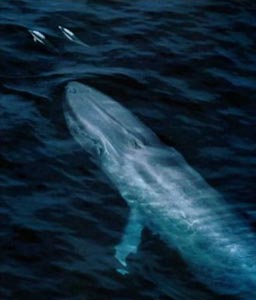

The order Cetacea comprises two extant sub-orders and one extinct sub-order. The extant sub-orders are the Mysticeti (baleen whales) and the Odontoceti (toothed whales). The extinct sub-order is the Archaeoceti (ancient whales). Both the mysticetes and odontocetes are thought to be descendants of the archaeocetes. Cetaceans, along with bats, are considered some of the most derived mammals on the planet. They evolved from terrestrial animals to an entirely aquatic life form that is completely separated from the land in all aspects of biology. Cetaceans live, breed, rest, and carry out all of their life functions in the water. The phylogenetic relationships discussed above are in the currently accepted form but many biologists still classify the Mysticetes and Odontocetes as separate orders.
All cetaceans share a number of similarities: they have a fusiform, or streamlined body shape; paddle shaped front limbs; vestigial hind limbs (which are within the body wall); no external digits or claws; tail flattened laterally and bearing horizontal flukes at the tip; vestigial ear pinnae; basically hairless body (some young have hair on their snouts); thick subcutaneous blubber layer filled with fat and oil; telescoped skull bones; external nares (blowhole) on the top of the head; addition of compressed vertebrae; shortening of the neck; lack of sweat glands; internal reproductive organs; 3-chambered stomach; and an airway reinforced with cartilage down to the alveoli. Many of these characteristics are adaptations to reduce drag for fast swimming in an aquatic environment. Protuberances such as external ears or genitals would create turbulence and would be very inefficient for an animal in the water.
Many cetaceans can dive for extended periods of time to great depths. Some cetaceans are thought to be the most intelligent non-primates and many have proportionately large brains. They also have remarkably efficient lungs and circulatory systems.
Sub-Order Mysticeti (Baleen whales)
4 families, 6 genera, and 11 species
This group consists of the very large whales, all greater than 7 meters long. The baleen whales feed primarily on plankton and krill. They lack teeth (as embryos they have vestigial, homodont teeth) and instead have a mesh of large, bumpy plates that hang from the upper jaw. These plates are used to strain food from the water. Different species have different density and coarseness of baleen due to their different food sources. Other distinguishing characteristics of this group include a double blowhole, a symmetrical skull, right and left halves of the the lower jaw unfused, and a single osseus sternum. Mysticetes often communicate with sounds including moans, thumps, and in one species, the humpback whale, with complex songs containing many syllables that may last a half hour or longer. Almost all mysticetes make seasonal, long-range migrations and are more common in the Antarctic and arctic regions. This group of whales (along with the sperm whale) was most affected by the whaling boom. Whalers sought them out because of their great size and for their baleen, meat, and oil. The widescale whaling of the past exists no longer, and most whales are now protected under international law.
This group includes the largest animal ever, the blue whale. These whales can reach 33.5 meters in length and weigh 160 tons.
The four families of mysticetes are:
Balaenidae -- right and bowhead whales Neobalaenidae -- pygmy right whale Balaenopteridae -- rorquals Eschrichtiidae -- gray whale
SubOrder Odontoceti (toothed whales)
9 families, 34 genera, and 68 species
This is a much larger and more diverse group than the mysticetes. They are usually small to medium sized (excluding the sperm whale) and dimorphic sexually. All members of this suborder have teeth, varying in number from 1 on each side of the lower jaw to 260 total. The teeth are usually unicuspid, conical, and homodont. The skull of odontocetes is bilaterally asymmetrical near the nares, and it supports a round, fatty organ called the melon. Other distinguishing characters include a single blowhole, a fused lower jaw, and a sternum composed of 3 or more bones. Odonticetes eat a variety of food including invertebrates, fish, squid, and other cetaceans. Prey is usually captured individually unlike the massive sieve feeding behavior of the mysticetes. Generally odontocetes are more social than mysticetes. Like mysticetes, they use sound, usually whistles and clicks, for communication, and it is also believed that they use these sounds for echolocation to find food and navigate. They are mostly marine creatures, but some families travel into rivers or live their entire lives there.
The families of Odontocetes are:
Physeteridae -- sperm whale Monodontidae -- narwhal and white whale Ziphiidae -- beaked whales Delphinidae -- ocean dolphins Phocoenidae -- porpoises Platanistidae -- river dolphinsPhylogenetic note: Recent evidence has suggested that the Physeteridae (sperm whale) family might be more closely related to the baleen whales than to the toothed whales. For a more detailed discussion see Milinkovitch (1995).
families of Mysticetes: Balaenidae -- right and bowhead whales Neobalaenidae -- pygmy right whale Balaenopteridae -- rorquals Eschrichtiidae -- gray whale families of Odontocetes: Physeteridae -- sperm whale Monodontidae -- narwhal and white whale Ziphiidae -- beaked whales Delphinidae -- ocean dolphins Phocoenidae -- porpoises Platanistidae -- river dolphins
<<<<<<<>>>>>>> ARTIODACTYLA CARNIVORA CETACEA CHIROPTERA DASYUROMORPHIA DERMOPTERA DIDELPHIMORPHI DIPROTODONTIA HYRACOIDEA INSECTIVORA LAGOMORPHA MACROSCELIDEA MICROBIOTHERIA MONOTREMATA NOTORYCTEMORPHIA PAUCITUBERCULATA PERAMELEMORPHIA PERISSODACTYLA PHOLIDOTA PRIMATES PROBOSCIDEA RODENTIA SCANDENTIA SIRENIA TUBULIDENTATA XENARTHRA
Email: eradani7@aol.com